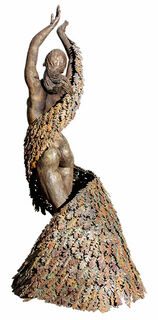Garden sculpture "Mother Earth Dances" (Original / Unique piece), bronze
Garden sculpture "Mother Earth Dances" (Original / Unique piece), bronze
Quick info
unique piece | bronze | hand-chased and hand-patinated | size 250 x 100 x 115 cm (h/w/d) | weight approx. 291 kg
Detailed description
Garden sculpture "Mother Earth Dances" (Original / Unique piece), bronze
The Roman Gaia, the African Konkomba, the South American Pachamama, the Indian Prithivi - mythologies all over the world know the motif of the primordial mother. Often, the origin of the world and nature are linked to highly revered female figures. Beth Newman-Maguire's "Dancing Mother Earth", who, wrapped in foliage, elegantly dances to distribute life and fertility, thus goes back to an ancient, archetypal myth - even if she knows how to express it in a stylistically highly modern way.
Unique piece in bronze, cast using the Lost-Wax-Process, chiselled and patinated by hand. Size 250 x 100 x 115 cm (h/w/d). Weight approx. 291 kg.
An alloy of copper with other metals (especially with tin) used since ancient times.
When casting bronze, the artist usually applies the lost-wax technique which is dating back more than 5000 years. It's the best, but also the most complex method of producing sculptures.
First, the artist forms a model of his sculpture. It is embedded in a liquid silicone rubber mass. Once the material has solidified, the model is cut out. The liquid wax is poured into the negative mould. After cooling down, the wax cast is removed from the mould, provided with sprues and dipped into ceramic mass. The ceramic mass is hardened in a kiln, whereby the wax flows out (lost mould).
Now we finally have the negative form, into which the 1400° C hot molten bronze is poured. After the bronze had cooled down, the ceramic shell is broken off and the sculpture is revealed.
Now the sprues are removed, the surfaces are polished, patinated and numbered by the artist himself or, to his specifications, by a specialist. Thus, each casting becomes an original work.
For lower-quality bronze castings, the sand casting method is often used which, however, does not achieve the results of a more complex lost-wax technique in terms of surface characteristics and quality.
A plastic work of sculptural art made of wood, stone, ivory, bronze or other metals.
While sculptures from wood, ivory or stone are made directly from the block of material, in bronze casting a working model is prepared at first. Usually, it is made of clay or other easily mouldable materials.
The prime time of sculpture after the Greek and Roman antiquity was the Renaissance. Impressionism gave a new impulse to the sculptural arts. Contemporary artists such as Jorg Immendorf, Andora, and Markus Lupertz also enriched sculptures with outstanding works.
A one-of-a-kind or unique piece is a work of art that has been personally created by the artist. It exists only once due to the type of production (oil painting, watercolours, drawing, etc.).
In addition to the classic unique pieces, there exist the so-called "serial unique pieces". They present a series of works with the same colour, motif and technique, manually prepared by the same artist. The serial unique pieces are rooted in "serial art", a type of modern art, that aims to create an aesthetic effect through series, repetitions and variations of the same objects or themes or a system of constant and variable elements or principles.
In the history of arts, the starting point of this trend was the work "Les Meules" (1890/1891) by Claude Monet, in which for the first time a series was created that went beyond a mere group of works. The other artists, who addressed to the serial art, include Claude Monet, Piet Mondrian and above all Gerhard Richter.






